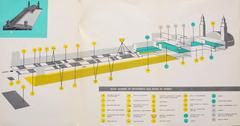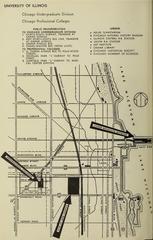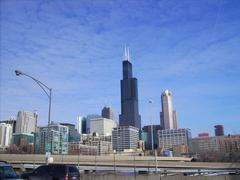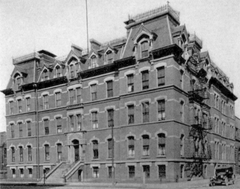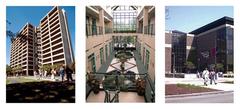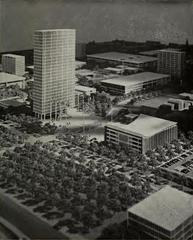
University of Illinois at Chicago (UIC) Visiting Guide: Tickets, Hours, and Tips
Date: 14/06/2025
The University of Illinois at Chicago (UIC) is a nationally renowned public research university and a landmark in Chicago’s educational, cultural, and architectural landscape. Whether you are a prospective student, history and architecture enthusiast, or a visitor eager to explore the city’s academic hubs, UIC offers a multifaceted experience rooted in its rich legacy, vibrant campus life, and integration with Chicago’s dynamic neighborhoods. This comprehensive guide provides everything you need to know for visiting UIC—covering its history, architecture, visitor hours, tours, accessibility, nearby attractions, and practical tips.
Table of Contents
- Overview and Significance
- Historical Foundations and Evolution
- Academic Excellence and Research Impact
- Diversity, Inclusion, and Social Justice
- Urban Engagement and Community Partnerships
- Arts, Culture, and Creative Innovation
- Campus Architecture and Layout
- Visiting UIC: Hours, Tours, and Visitor Information
- Key Campus Facilities and Outdoor Spaces
- Nearby Neighborhoods and Cultural Attractions
- Visitor Services and Amenities
- Frequently Asked Questions (FAQ)
- Conclusion and Final Tips
- References
Overview and Significance
UIC has evolved from a collection of 19th-century health colleges into one of the nation’s most diverse and innovative research universities. Situated on Chicago’s Near West Side, UIC’s campus is woven into the urban fabric, reflecting a deep commitment to academic excellence, community engagement, and social justice (UIC History; University of Illinois History). Today, it serves nearly 34,000 students across 15 colleges and is recognized for cutting-edge research, interdisciplinary collaboration, and a spirit of inclusion. Its proximity to Greektown, Little Italy, and Pilsen, as well as museums like the National Hellenic Museum and the National Museum of Mexican Art, further enhances the visitor experience (UIC Visit Campus; UIC Campus Tours).
Historical Foundations and Evolution
19th-Century Health Sciences Roots
UIC’s foundations date back to the Chicago College of Pharmacy (1859), the College of Physicians and Surgeons (1882), and the Columbian College of Dentistry (1891). These colleges joined the University of Illinois in the late 19th century, forming a robust health sciences presence on Chicago’s Near West Side. By the 1930s, the consolidated professional colleges established one of the world’s largest concentrations of medical institutions (UIC History; University of Illinois History; UIC History, Traditions, Symbols).
Navy Pier Era and Expansion
After World War II, UIC launched an undergraduate division at Navy Pier in 1946 to accommodate returning veterans. Over two decades, this site democratized higher education for tens of thousands of students (UIC History, Traditions, Symbols).
The Circle Campus and Modernist Vision
In 1965, the University of Illinois at Chicago Circle (UICC) opened on a new, modernist campus designed by Walter Netsch. The campus’s distinctive concentric layout and bold architectural style set it apart as an emblem of mid-20th century academic design (UIC History; University of Illinois History).
Consolidation and Birth of UIC
In 1982, UICC merged with the Medical Center, creating the unified UIC campus. This move fostered interdisciplinary research and enabled UIC to achieve Carnegie Research I status by 1987, solidifying its national reputation (UIC History; University of Illinois History).
Great Cities Commitment and 21st-Century Growth
Since the 1990s, UIC has focused on urban engagement through its Great Cities Commitment, integrating research and teaching with community needs. The 2000s South Campus expansion revitalized the historic Maxwell Street area and enhanced student life, amenities, and sustainability initiatives (University of Illinois History; Maxwell Street Foundation).
Academic Excellence and Research Impact
UIC ranks among the top U.S. public research universities, noted for strengths in medicine, engineering, computer science, and the arts. Its medical school is the nation’s largest, and UIC is recognized globally for high research output and impact (Times Higher Education; EduRank). With 15 colleges and a robust commitment to interdisciplinary collaboration, UIC addresses complex urban and global challenges.
Diversity, Inclusion, and Social Justice
UIC boasts one of the nation’s most diverse student bodies, with deep roots in Chicago’s communities. Nearly 40% of new students come from Chicago Public Schools, and the university is a leader in supporting underrepresented groups through initiatives like the Centers for Cultural Understanding and Social Change (UIC Diversity). UIC’s Native American Support Program and the Native American and Indigenous Inclusion and Belonging initiative reflect its dedication to social justice and equity (UIC Diversity).
Urban Engagement and Community Partnerships
UIC’s urban mission is reflected in its partnerships with local organizations and efforts to address citywide needs—from public health to economic development. Environmental sustainability efforts, such as the award-winning Heritage Garden, underscore the university’s leadership in green campus practices (UIC Diversity).
Arts, Culture, and Creative Innovation
UIC is a cultural powerhouse in the city, home to the College of Architecture, Design, and the Arts (CADA), and recognized internationally for excellence in art, design, and creative research (UIC Today). The university’s galleries, performance venues, and partnerships with Chicago’s leading theaters and museums offer visitors access to a vibrant arts ecosystem (EduRank).
Campus Architecture and Layout
UIC’s campus, divided into East and West sections, features an array of modernist and traditional buildings. The East Campus, designed by Walter Netsch, is notable for its brutalist architecture and elevated walkways, while the West Campus retains historic health sciences buildings. Expansive green spaces, plazas, and public art installations provide a dynamic, walkable environment. The South Campus expansion has added new research and residential facilities, further integrating UIC with its urban surroundings.
Visiting UIC: Hours, Tours, and Visitor Information
Hours and Admission
- Campus Grounds: Open daily from dawn to dusk.
- Daley Library: Monday–Friday 8:00 AM–10:00 PM; weekends 10:00 AM–6:00 PM (Daley Library hours).
- Gallery 400: Tuesday–Saturday 11:00 AM–5:00 PM.
- Jane Addams Hull-House Museum: Tuesday–Saturday 11:00 AM–4:00 PM.
Admission to campus and most buildings is free. Special events or exhibitions may require tickets (UIC Campus Tours).
Guided and Self-Guided Tours
- Student-Led Campus Tours: Offered Monday–Friday and select Saturdays (60–90 minutes). Reservations are recommended (UIC College of Education Visit Campus).
- Self-Guided Tours: Download maps and guides online (UIC Admissions Self-Guided Tours).
- Virtual Tours: Available for remote visitors.
Accessibility
UIC provides accessible entrances, elevators, and restrooms throughout campus. Visitors needing accommodations should contact the Disability Resource Center in advance.
Parking, Transportation, and Travel Tips
- Public Transit: Accessible via CTA Blue Line (UIC-Halsted station) and several bus routes.
- Parking: Multiple garages and lots; visitor rates apply (UIC Parking Services).
- Travel Tips: Use public transit to avoid parking fees; wear comfortable shoes for exploring; check building hours before your visit.
Key Campus Facilities and Outdoor Spaces
- Richard J. Daley Library: Central hub for study and research.
- Health Sciences Library: Supports medical and health programs.
- Student Centers East and West: Dining, student services, and wellness resources.
- Credit Union 1 Arena: Home to UIC Flames basketball, concerts, and large events (UIC Summer Events).
- Gallery 400: Contemporary art and design exhibitions.
- Jane Addams Hull-House Museum: Historic site honoring social reformer Jane Addams.
- Cultural Centers: African American, Latino, Asian American, and other cultural spaces.
- Athletics and Recreation: NCAA Division I sports, fitness centers, and recreational facilities.
Nearby Neighborhoods and Cultural Attractions
UIC’s location offers visitors easy access to some of Chicago’s most vibrant districts:
- Greektown: Renowned for Greek cuisine and culture.
- Little Italy (Taylor Street): Italian eateries and bakeries.
- Pilsen: Murals, galleries, and Mexican food.
- Maxwell Street Market: Historic open-air market for food and entertainment (Secret Chicago).
- Downtown Chicago: The Loop, Millennium Park, and the Art Institute are a short transit ride away.
Visitor Services and Amenities
- Dining: Wide selection on campus and in adjacent neighborhoods.
- Shopping: Campus shops and local businesses.
- Accommodations: On-campus housing (limited for guests) and nearby hotels.
- Safety: UIC and Chicago Police ensure campus security; after-hours escort services available.
- Events: Lectures, performances, festivals, and Spark in the Park music festival.
Frequently Asked Questions (FAQ)
Q: What are UIC’s visiting hours?
A: Campus grounds are open daily from dawn to dusk; building hours vary—check online before visiting.
Q: Are guided campus tours available?
A: Yes, guided tours are available Monday–Friday; reserve in advance online.
Q: Is there an admission fee?
A: No, general campus access is free. Some events or exhibitions may require tickets.
Q: How do I get to UIC by public transport?
A: Take CTA Blue Line to UIC-Halsted station or use bus routes serving the campus area.
Q: Is the campus accessible for those with disabilities?
A: Yes, UIC is fully accessible. Contact the Disability Resource Center for specific needs.
Q: Are there dining options nearby?
A: Yes, both on campus and in Greektown, Little Italy, and Pilsen.
Q: Can I take a virtual tour?
A: Yes, virtual tours are available on the admissions website.
Conclusion and Final Tips
Visiting the University of Illinois at Chicago immerses you in a living legacy of academic innovation, urban engagement, and cultural diversity. UIC’s campus is a showcase of modernist architecture, public art, and green spaces, while its surrounding neighborhoods offer a taste of Chicago’s multicultural vibrancy. Plan ahead by checking event calendars, booking tours, and using public transit for a hassle-free experience.
For the latest updates on campus tours, events, and visitor resources, explore UIC’s official websites and download the Audiala app for guided maps and insider tips. Whether you are drawn by its history, academic reputation, or urban setting, UIC promises a memorable and enriching visit.
References
- UIC History
- University of Illinois History
- Times Higher Education
- Maxwell Street Foundation
- EduRank
- UIC Diversity
- UIC Campus Tours
- UIC Visit Campus
- UIC College of Education Visit Campus
- UIC Admissions Self-Guided Tours
- Daley Library hours
- UIC Parking Services
- UIC Summer Events
- Secret Chicago
